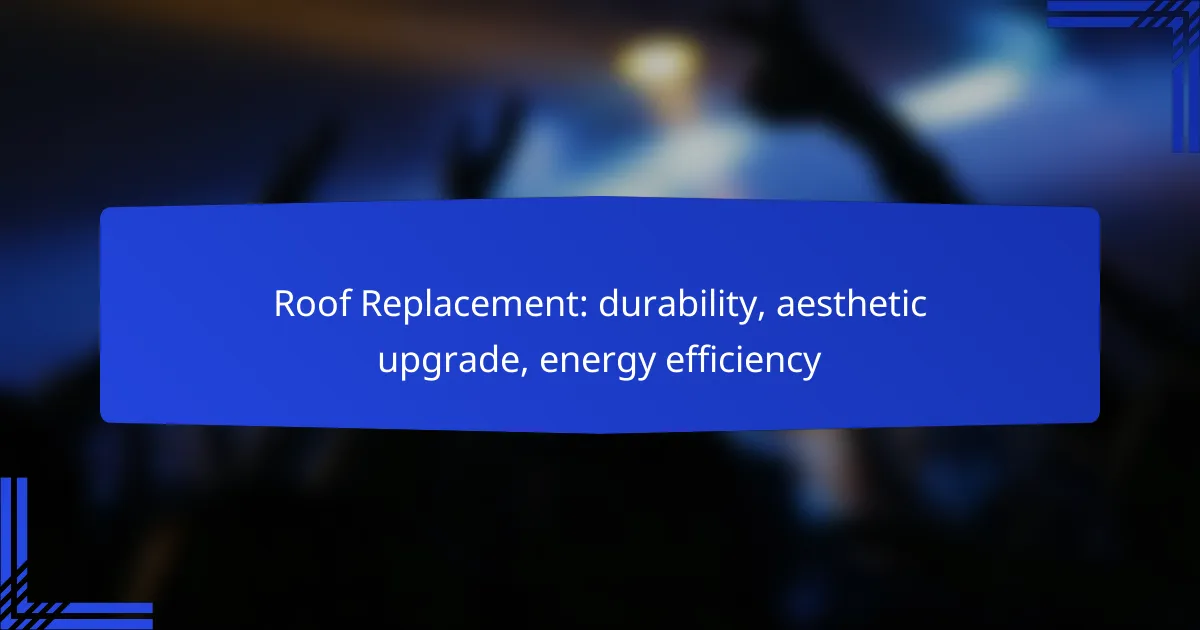Roof replacement is a significant investment that enhances your home’s durability, aesthetic appeal, and energy efficiency. By choosing the right materials, homeowners can not only improve the overall look of their property but also increase its value and comfort. Understanding the benefits and costs associated with different roofing options is essential for making an informed decision.

What are the benefits of roof replacement in the UK?
Roof replacement in the UK offers several advantages, including improved durability, enhanced aesthetics, and better energy efficiency. These benefits contribute to the overall value and comfort of a home, making it a worthwhile investment.
Improved durability
Replacing an old roof can significantly increase the durability of your home. New roofing materials, such as slate, tile, or high-quality asphalt shingles, are designed to withstand harsh weather conditions typical in the UK, including heavy rain and strong winds.
When selecting materials, consider options that come with long warranties, often ranging from 20 to 50 years. This can provide peace of mind and reduce the need for frequent repairs or replacements.
Aesthetic upgrade
A new roof can dramatically enhance the visual appeal of your home. With a variety of styles, colors, and materials available, homeowners can choose options that complement their property’s architecture and improve curb appeal.
Consider selecting roofing materials that match or enhance the existing features of your home. For instance, a modern slate roof can add a contemporary touch to a traditional brick house, increasing its market value.
Enhanced energy efficiency
Roof replacement can lead to improved energy efficiency, helping to reduce heating and cooling costs. Modern roofing materials often include better insulation properties, which can help maintain a consistent indoor temperature.
When replacing your roof, consider options with reflective coatings or energy-efficient designs. These can lower energy bills by minimizing heat absorption during the summer months and retaining warmth in winter, potentially saving homeowners a significant percentage on energy costs over time.
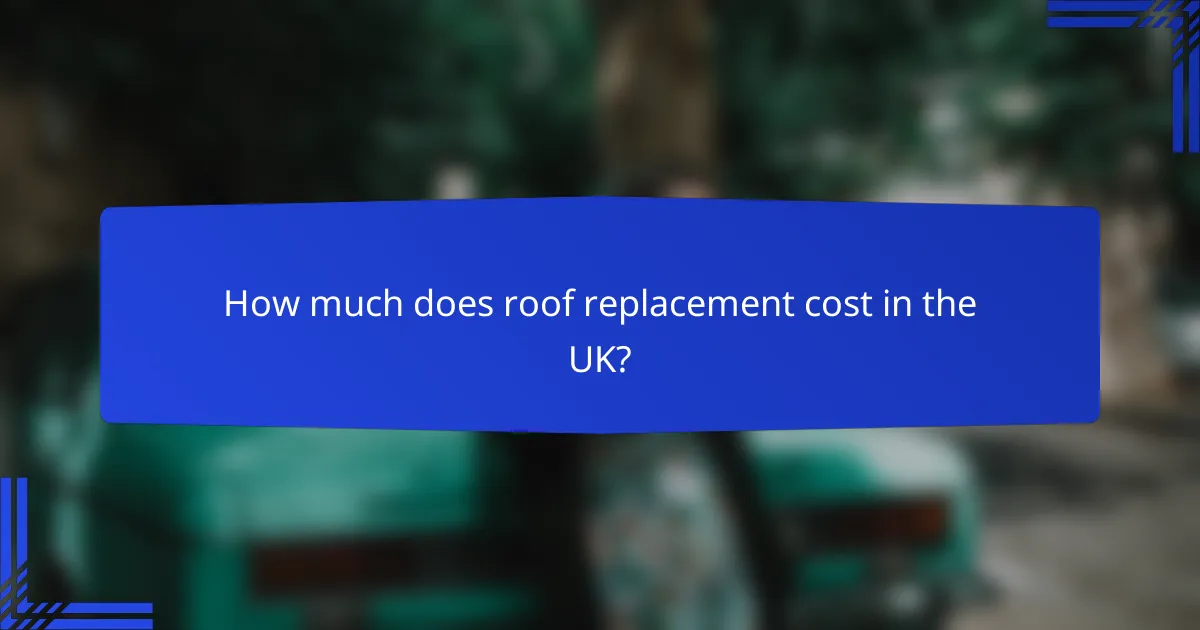
How much does roof replacement cost in the UK?
The cost of roof replacement in the UK typically ranges from £4,000 to £10,000, depending on various factors such as materials and roof size. Homeowners should budget accordingly and consider both immediate expenses and long-term benefits.
Average cost range
The average cost for replacing a roof in the UK generally falls between £4,000 and £10,000. For smaller homes, costs may start around £3,000, while larger properties or those requiring high-end materials can exceed £15,000. It’s essential to obtain multiple quotes to ensure a fair price.
Different roofing materials also influence costs significantly. For instance, a basic asphalt shingle roof may be less expensive than a slate or tile roof, which can drive up the overall expense.
Factors influencing cost
Several factors can affect the total cost of roof replacement. The size of the roof is a primary consideration; larger roofs require more materials and labor, increasing the overall price. Additionally, the complexity of the roof design, such as multiple slopes or features like chimneys, can add to the cost.
The choice of materials is another critical factor. High-quality materials, while more expensive upfront, often provide better durability and energy efficiency, potentially saving money in the long run. Local labor rates and the time of year can also impact pricing, with peak seasons often leading to higher costs.
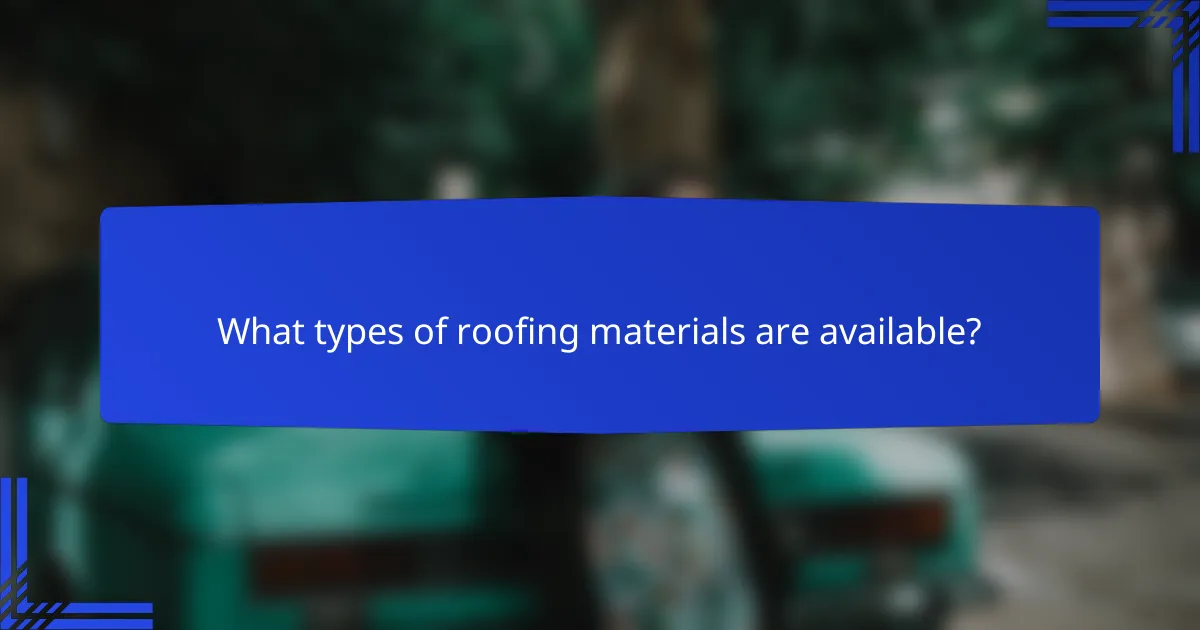
What types of roofing materials are available?
There are several roofing materials available, each offering different benefits in terms of durability, aesthetics, and energy efficiency. The most common types include asphalt shingles, slate tiles, and metal roofing, each with unique characteristics that cater to various preferences and budgets.
Asphalt shingles
Asphalt shingles are the most popular roofing material in North America due to their affordability and ease of installation. They typically last around 15 to 30 years and come in a variety of colors and styles, allowing for aesthetic flexibility.
When considering asphalt shingles, look for those with a high warranty rating, as this often indicates better durability. Be aware that they may not perform as well in extreme weather conditions compared to other materials.
Slate tiles
Slate tiles are known for their exceptional durability and long lifespan, often exceeding 50 years. They provide a classic, elegant look that can significantly enhance a home’s curb appeal.
However, slate is heavier and more expensive than other roofing options, requiring a reinforced roof structure. It’s essential to hire a qualified contractor for installation to ensure proper handling and longevity.
Metal roofing
Metal roofing is gaining popularity for its durability and energy efficiency, with a lifespan of 40 to 70 years. It reflects solar heat, which can reduce cooling costs in warmer climates.
Available in various materials like steel, aluminum, and copper, metal roofs can be more expensive upfront but often pay off in energy savings and longevity. Ensure proper installation to avoid issues like rust or leaks, and consider local building codes regarding metal roofing materials.

How to choose the right roofing contractor?
Choosing the right roofing contractor is crucial for ensuring quality work and a successful roof replacement. Focus on their experience, credentials, and customer feedback to make an informed decision.
Check credentials
Verify that the roofing contractor holds the necessary licenses and insurance required in your area. This typically includes liability insurance and workers’ compensation to protect you from potential liabilities during the project.
Additionally, check if the contractor is certified by roofing material manufacturers, as this often indicates a higher level of expertise and adherence to industry standards. A certified contractor may also offer extended warranties on materials and workmanship.
Read reviews
Reading customer reviews can provide valuable insights into a contractor’s reliability and quality of work. Look for reviews on reputable platforms like Google, Yelp, or Angie’s List to gauge overall customer satisfaction.
Pay attention to recurring themes in the reviews, such as punctuality, communication, and the quality of the finished roof. Aim for contractors with a majority of positive feedback, but don’t shy away from those with a few negative reviews if they show a commitment to resolving issues.

What are the signs that you need a roof replacement?
Signs that indicate you need a roof replacement include visible damage, significant wear due to age, and reduced energy efficiency. Addressing these issues promptly can prevent further complications and expenses.
Visible damage
Visible damage on your roof can manifest as missing shingles, cracks, or leaks. If you notice water stains on your ceiling or walls, it may indicate that your roof is compromised and needs replacement.
Additionally, look for curling or buckling shingles, as these are signs of deterioration. Regular inspections can help you catch these issues early, allowing for timely repairs or a full replacement.
Age of the roof
The age of your roof is a critical factor in determining whether it needs replacement. Most roofs have a lifespan of 20 to 30 years, depending on the materials used. If your roof is approaching or exceeding this age, it may be time to consider a replacement.
Even if there are no visible signs of damage, older roofs can become less effective at protecting your home. If your roof is nearing the end of its expected life, consult a professional to evaluate its condition and discuss your options.
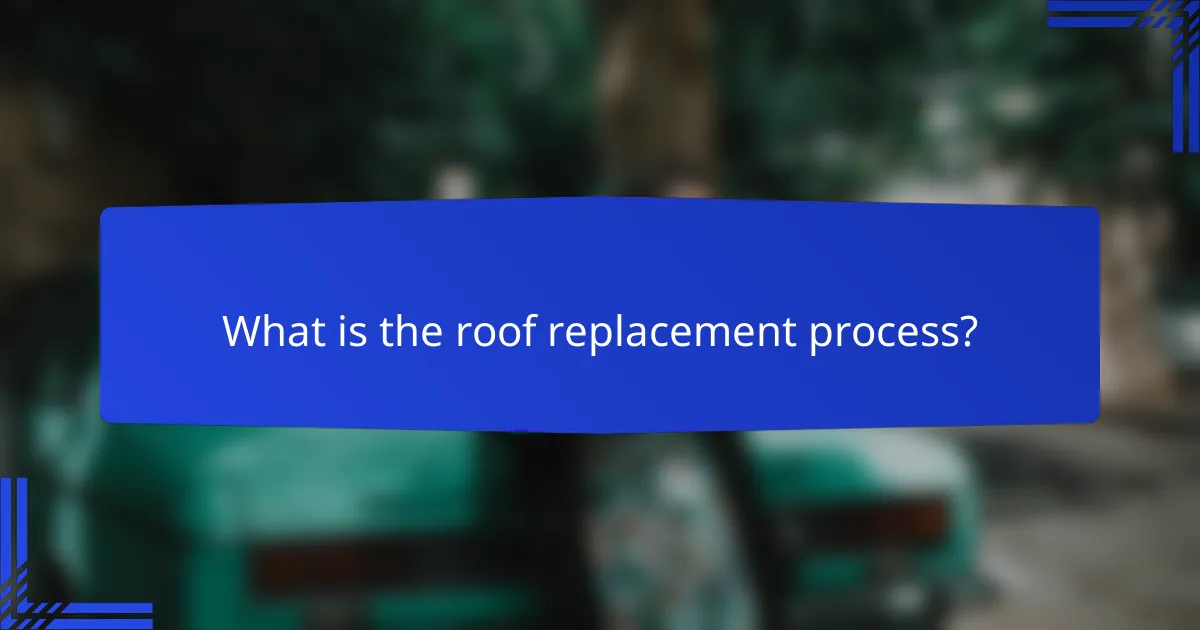
What is the roof replacement process?
The roof replacement process involves several key steps to ensure a durable, aesthetically pleasing, and energy-efficient roof. This typically includes an initial inspection, material selection, and installation steps that must be carefully followed to achieve optimal results.
Initial inspection
The initial inspection is crucial for assessing the current condition of your roof and identifying any underlying issues. A professional should examine the roof for damage, leaks, and structural integrity, which can influence the replacement strategy.
During this inspection, it’s important to check for signs of wear, such as missing shingles or water stains inside the home. This evaluation helps determine whether a full replacement is necessary or if repairs can suffice.
Material selection
Choosing the right materials for your roof replacement is essential for durability and energy efficiency. Common options include asphalt shingles, metal roofing, and tile, each offering different benefits and costs.
Consider factors like climate, aesthetics, and budget when selecting materials. For example, metal roofs can last longer but may have a higher upfront cost compared to asphalt shingles, which are more affordable but have a shorter lifespan.
Installation steps
The installation of a new roof typically involves several steps, starting with removing the old roofing material. This is followed by repairing any underlying damage to the roof deck before laying down new underlayment and shingles or other chosen materials.
Ensure that the installation adheres to local building codes and standards, which can vary by region. Proper ventilation and insulation should also be considered during installation to enhance energy efficiency and prolong the roof’s lifespan.
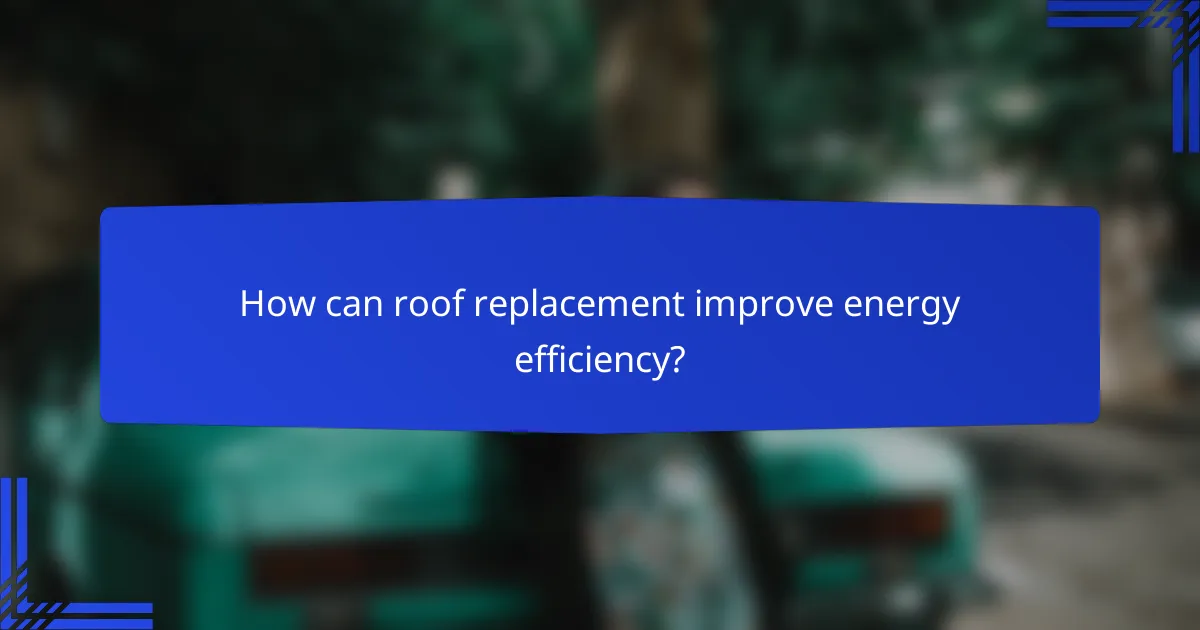
How can roof replacement improve energy efficiency?
Roof replacement can significantly enhance energy efficiency by utilizing modern materials and designs that reduce heat loss and improve insulation. Upgrading to energy-efficient roofing can lead to lower energy bills and a more comfortable indoor environment.
Insulation benefits
New roofing systems often incorporate advanced insulation materials that help maintain consistent indoor temperatures. Effective insulation minimizes heat transfer, keeping homes warmer in winter and cooler in summer. This can result in energy savings of around 20-30% on heating and cooling costs.
When selecting insulation, consider options like spray foam or rigid foam boards, which offer superior thermal resistance. Ensure that the insulation is installed correctly to maximize its effectiveness and adhere to local building codes.
Reflective materials
Reflective roofing materials, such as cool roofs, can significantly reduce heat absorption from sunlight. These materials reflect more sunlight and absorb less heat, which can lower indoor temperatures and decrease reliance on air conditioning. In warm climates, this can lead to energy savings of 10-20% during peak summer months.
When choosing reflective materials, look for those with high Solar Reflectance Index (SRI) ratings. Additionally, consider the color and finish of the roofing; lighter colors tend to be more effective at reflecting sunlight compared to darker shades.
